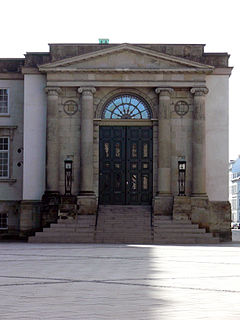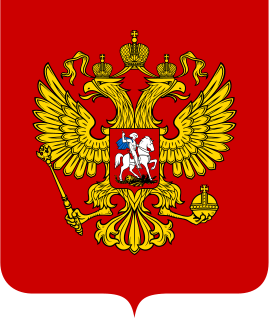Related Research Articles

A jury trial, or trial by jury, is a lawful proceeding in which a jury makes a decision or findings of fact. It is distinguished from a bench trial in which a judge or panel of judges makes all decisions.
A court-martial or court martial is a military court or a trial conducted in such a court. A court-martial is empowered to determine the guilt of members of the armed forces subject to military law, and, if the defendant is found guilty, to decide upon punishment. In addition, courts-martial may be used to try prisoners of war for war crimes. The Geneva Convention requires that POWs who are on trial for war crimes be subject to the same procedures as would be the holding military's own forces. Finally, courts-martial can be convened for other purposes, such as dealing with violations of martial law, and can involve civilian defendants.

The General Court, informally known as the European General Court (EGC), is a constituent court of the Court of Justice of the European Union. It hears actions taken against the institutions of the European Union by individuals and member states, although certain matters are reserved for the European Court of Justice. Decisions of the General Court can be appealed to the Court of Justice, but only on a point of law. Prior to the coming into force of the Lisbon Treaty on 1 December 2009, it was known as the Court of First Instance.

The Courts of Denmark is the ordinary court system of the Kingdom of Denmark. The Courts of Denmark as an organizational entity was created with the Police and Judiciary Reform Act taking effect 1 January 2007 which also significantly reformed the court system e.g. by removing original jurisdiction from the High Courts and by introducing a new jury system.

The Exchequer of Pleas or Court of Exchequer was a court that dealt with matters of equity, a set of legal principles based on natural law and common law in England and Wales. Originally part of the curia regis, or King's Council, the Exchequer of Pleas split from the curia during the 1190s, to sit as an independent, central court. The Court of Chancery's reputation for tardiness and expense resulted in much of its business transferring to the Exchequer. The Exchequer and Chancery, with similar jurisdictions, drew closer together over the years, until an argument was made during the 19th century that having two seemingly identical courts was unnecessary. As a result, the Exchequer lost its equity jurisdiction. With the Judicature Acts, the Exchequer was formally dissolved as a judicial body by an Order in Council of 16 December 1880.
A county is the name of a type of administrative unit in the Kingdom of Hungary and in Hungary from the 10th century until the present day.

The Palatine of Hungary was the highest-ranking office in the Kingdom of Hungary from the beginning of the 11th century to 1848. Initially, Palatines were representatives of the monarchs, later the vice-regent (viceroy). In the early centuries of the kingdom, they were appointed by the king, and later were elected by the Diet of the Kingdom of Hungary. Palatine's jurisdiction included only Hungary proper, in the Kingdom of Croatia until 1918 the ban held similar function as the highest office in the Kingdom, monarch's representative, commander of the royal army and viceroy.
The word prothonotary is recorded in English since 1447, as "principal clerk of a court," from L.L. prothonotarius, from Greek protonotarios "first scribe," originally the chief of the college of recorders of the court of the Byzantine Empire, from Greek πρῶτοςprotos "first" + Latin notarius ("notary"); the -h- appeared in Medieval Latin. The title was awarded to certain high-ranking notaries.

The Judiciary of Russia interprets and applies the law of Russia. It is defined under the Constitution and law with a hierarchical structure with the Constitutional Court and Supreme Court at the apex. The district courts are the primary criminal trial courts, and the regional courts are the primary appellate courts. The judiciary is governed by the All-Russian Congress of Judges and its Council of Judges, and its management is aided by the Judicial Department of the Supreme Court, the Judicial Qualification Collegia, the Ministry of Justice, and the various courts' chairpersons. And although there are many officers of the court, including jurors, the Prosecutor General remains the most powerful component of the Russian judicial system.

The Kingdom of Croatia-Slavonia was a nominally autonomous kingdom and constitutionally defined separate political nation within the Austro-Hungarian Empire, created in 1868 by merging the kingdoms of Croatia and Slavonia following the Croatian–Hungarian Settlement of 1868. It was associated with the Hungarian Kingdom within the dual Austro-Hungarian state, being within the Lands of the Crown of St. Stephen, also known as Transleithania. While Croatia had been granted a wide internal autonomy with "national features", in reality, Croatian control over key issues such as tax and military issues was minimal and hampered by Hungary. It was internally officially referred to as the Triune Kingdom of Croatia, Slavonia and Dalmatia, also simply known as the Triune Kingdom, and had claims on Dalmatia, which was administrated separately by the Austrian Cisleithania. The city of Rijeka, following a disputed section in the 1868 Settlement known as the Rijeka Addendum, became a corpus separatum and was legally owned by Hungary, but administrated by both Croatia and Hungary.
In some jurisdictions, an assessor is a judge's or magistrate's assistant. This is the historical meaning of this word.
The ispán or count was the leader of a castle district in the Kingdom of Hungary from the early 11th century. Most of them were also heads of the basic administrative units of the kingdom, called counties, and from the 13th century the latter function became dominant. The ispáns were appointed and dismissed by either the monarchs or a high-ranking royal official responsible for the administration of a larger territorial unit within the kingdom. They fulfilled administrative, judicial and military functions in one or more counties.
The Tabula Banalis was the supreme court of Croatia. It was established in 1723 by Charles VI, ruler of the Habsburg Monarchy. The court was presided over by the Ban of Croatia or by his deputy. For more important trials it was the first instance court, and served as the court of appeal for verdicts of the county courts.

Pontificalis Domus was a motu proprio document issued by Pope Paul VI on 28 March 1968, in the fifth year of his pontificate. It reorganized the Papal Household, which had been known until then as the Papal Court.

The master of the treasury or treasurer was a royal official in the Kingdom of Hungary from the 12th century. Although treasurers were initially responsible for collecting and administering royal revenues, they adopted more and more judiciary functions and turned into the highest judges of the realm. From the 14th century, treasurers presided over the court of appeals for a group of the free royal cities, including Buda, Bártfa, Eperjes, Kassa, Nagyszombat and Pressburg (Pozsony).

The chief justice was the personal legal representative of the King of Hungary, who issued decrees of judicial character on behalf of the monarch authenticated with the royal seal, performed national notarial activities and played an important role in the organisation of lawyers training. Later the chief justice was the head of the Royal Court of Justice and the Tribunal of the Chief Justice, the highest legal forum of civil cases.
The judiciary of Luxembourg comprises a number of courts.

John Hont-Pázmány was a prelate in the Kingdom of Hungary at the turn of the 13th and 14th centuries. He was Archbishop of Kalocsa between 1278 and 1301. In this capacity, he closely cooperated with fellow Archbishop Lodomer in order to restore royal authority over the kingdom. After Lodomer's death, John became head of the royal council from 1298 to 1301, initiating profound constitutional changes in the parliamentary system. He crowned Wenceslaus, one of the pretenders to Hungary, king in 1301, provoking the wrath of the Holy See.

Ladislaus I from the kindred Kán was a powerful Hungarian baron, who held several secular positions during the reign of kings Andrew II and Béla IV.

Makján (II) from the kindred Aba was a Hungarian lord in the 13th century, who served as Palatine of Hungary from 1286 to 1287. He was a staunch supporter of Ladislaus IV of Hungary.
References
- ↑ Robert John Weston Evans The Making of the Habsburg Monarchy, 1550-1700: An Interpretation, p. 239, Oxford University Press, 1979 ISBN 0-19-873085-3, ISBN 978-0-19-873085-9.